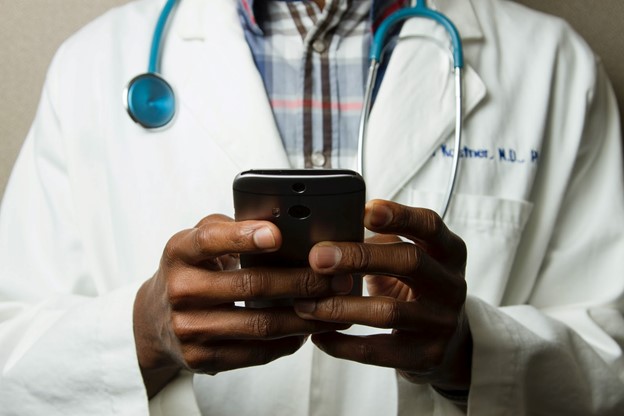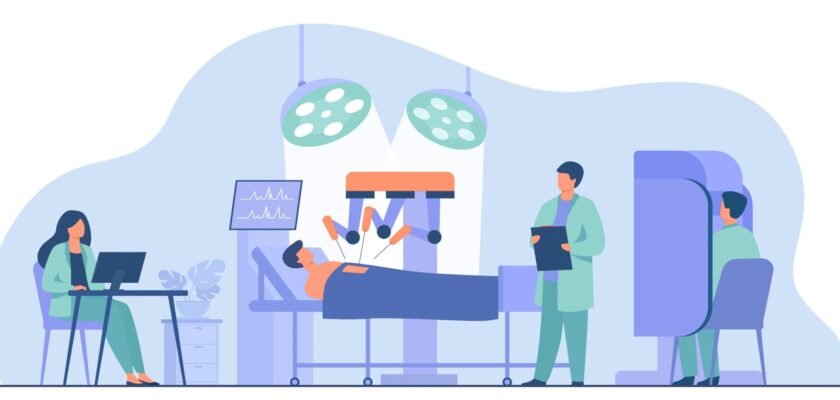Technology can turn hours spent in waiting rooms into a personalized, online check-up experience. Artificial intelligence is already preventing surgical errors and saving lives. The future of technology in healthcare will optimize patient experience, and it has already begun. With the rise of telehealth and frontline staffing solutions, healthcare is advancing towards a more accessible, connected system.
Improve Clinical Research & Patient Outcome Process with AI (Artificial Intelligence)
Automation in Healthcare
Imagine you could go to any hospital in the world without filling a single form. Or perhaps you can even do it from the comfort of your own home, with a doctor on the other side of the screen. Automation in healthcare is the key to accessibility, eliminating data entry and needless wait times. Here are some examples of strides we are already taking towards seamless healthcare systems.
Patients Care Management Application
Virtual care services like Maple application can connect patients with doctors in under two minutes on a smartphone or computer, 24/7. For situations that require an in-person checkup, patients can book ahead of time and get real-time updates on wait time. That way, fewer people need to crowd waiting rooms or emergency rooms which spread germs. Managing appointments for virtual and in-person meetings has never been so simple.
Insider tip: Online resources need to be accessible to a variety of patients. Follow accessible design principles for your website so that your resource is easy for anyone to use. Ensure the size of your text and the color contrast with the background promotes readability. For those who are visually impaired, providing alt-text for images and videos greatly improves their experience on your site.
Chatbots in Healthcare
Chatbots can assist patients by symptom-checking and listening to patient concerns immediately. If further care is needed, a healthcare professional will already have the requisite background information before attending to a patient. This allows doctors to free up their time for more complicated diagnostics. With chatbots, no patient is put on hold or waiting in line to get their initial assessment.
AI Connected Healthcare System
AI can improve the accessibility in the clinical research process, which helps scientists discover treatments faster at a lower cost. By automatically matching the right candidates to specific research, scientists can save time filtering through medical information. People with different genetics and medical history respond differently to the same treatment.
The future of healthcare will be customized, with treatment that is personalized for the individual’s needs. The research carried out today is critical for advancing treatments of tomorrow.
The world is rapidly moving towards a connected healthcare system where patients and practitioners don’t need to jump through hoops for a health assessment, research, or treatment. With more sophisticated health trackers coming out, you won’t need to go into a doctor’s office to get an electrocardiogram or blood pressure check.
It won’t be long before you and your family doctor can opt-in for notifications if there are disruptions in your body or predictions of upcoming problems.
Improving Patient Outcomes with Artificial Intelligence and More
It’s natural for new team members to make mistakes and learn on the fly. When you work as a surgeon or a radiologist screening for cancer, the consequences can be deadly. Technology can support frontline workers, saving lives by helping healthcare professionals perform better. Here is how artificial intelligence, virtual reality, and augmented reality are changing the way new generations of healthcare professionals serve.

Read More – 15 Therapeutic Communication Techniques by Nurses
New surgeons can learn faster with an operating room (OR) black box that records data during surgeries. It gives automated feedback in real-time, accompanied by AR visuals to guide practitioners. OR Black Box uses AI to assess the technical skill of instruments being used and support surgeons by identifying events such as bleeding or thermal injury.
Meanwhile, the identity of surgeons in the room is protected so the black box only reports clinically relevant information as a teaching tool. This gives patients the best possible outcome without breaching the medical professional’s privacy.
Human radiologists are being outperformed by A.I. in breast cancer analysis by an average of 11.5%. Increasing the accuracy of early diagnostics completely transforms the future of cancer care. This reduces the number of false positives and ensures patients receive the treatment they need for recovery. Machine learning technology is being used to assist pathologists with more accurate diagnoses for many diseases.
Surgical students that receive training in virtual reality finish procedures 20% faster than those that do not, with 38% of steps done more correctly. Every year, over 7 million patients experience surgical complications which can be prevented with stronger training.
At the same time, augmented reality is being used to train medical students, giving them a more in-depth understanding of anatomy even without situational experience.
Doctors and nurses work long, exhausting shifts, and technology can offload tasks to automation. Technology that empowers healthcare managers and frontline workers to do their work better translates into higher quality patient care. Even small things like streamlining medical records make an impact on their workflow.
Smarter Preparation for Patient Care
Hospitals are constantly improving their processes, whether it is how they transport equipment or manage their staff. Behind the scenes of the emergency room, here are advances that are making it easier for healthcare professionals to prepare for patient care.
Smart employee scheduling and temp staffing platforms like Hyre ensure that healthcare professionals are not short-staffed and unavailable to patients. During the pandemic, team members that contract COVID-19 cannot return to work. HR platforms can keep a digital trail to streamline communication about infections and staff who need to get tested. With Hyre, scheduling replacements is just as easy. Their temp staffing marketplace ensures qualified and available temp staff can fill in gaps in the workforce.
3D printing in Medicine and Healthcare
3D printing in medicine and healthcare makes artificial limbs, and even customized pills more accessible. It’s one thing to print parts for medical equipment more affordably, but what about printing biological components? There are methods in development to print living skin and blood vessels that will eventually transfer blood and nutrients into the human body. Perhaps one day, entire organs can be printed.
Role of Smart Pills in Healthcare
Smart pills with tiny cameras are helping doctors see what is going on inside your body in a non-invasive way. Simply swallow the pill, and get a colon exam done. There are other electronic pills that can not only help doctors with diagnostics but release drugs in response to smartphone commands. Imagine automating the pills you need to take every day. Nanotechnology can transform the future of patient treatment and testing.
Smart Patch
You can use a smart patch to monitor wounds and stimulate healing, but what is going on deeper within your body? With more affordable genome sequencing, people can learn more about their body’s specific needs based on their DNA. There is a lot that can be done for your health before seeing a doctor or getting on a surgery table. Instead of responding to symptoms, connected care takes a proactive approach in maintaining wellbeing.
Surgical vending machines
From patient experience to preparing healthcare professionals, this is just the beginning. Many more advances are coming until a global universal healthcare system can be realized. Medical supplies are already being delivered by drones to remote areas. Surgical vending machines are making equipment more accessible than ever.
Perhaps a day will come when 5G internet enables surgeons to perform virtually through robots, eliminating the physical barrier that prevents individuals in remote regions from receiving care.
What technology are you most looking forward to improving the healthcare space?
Read More –What is Health Informatics

